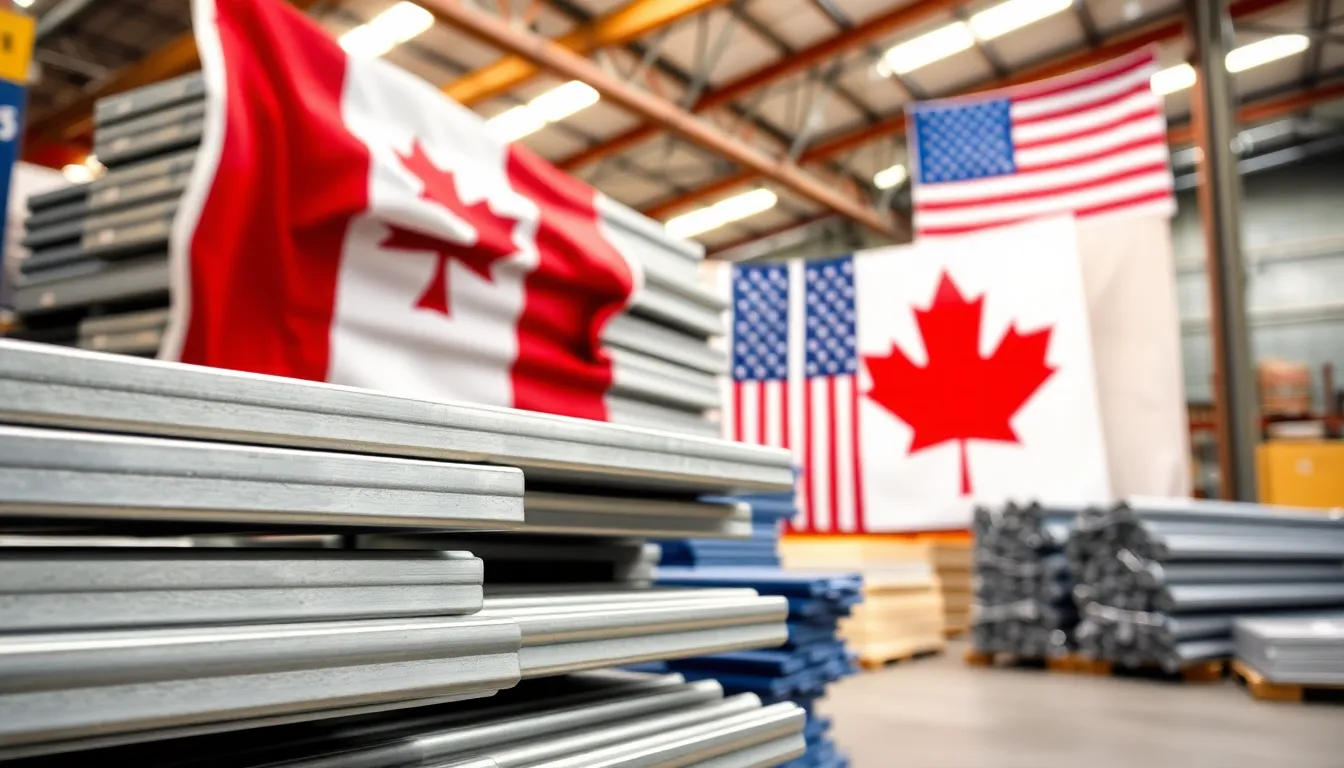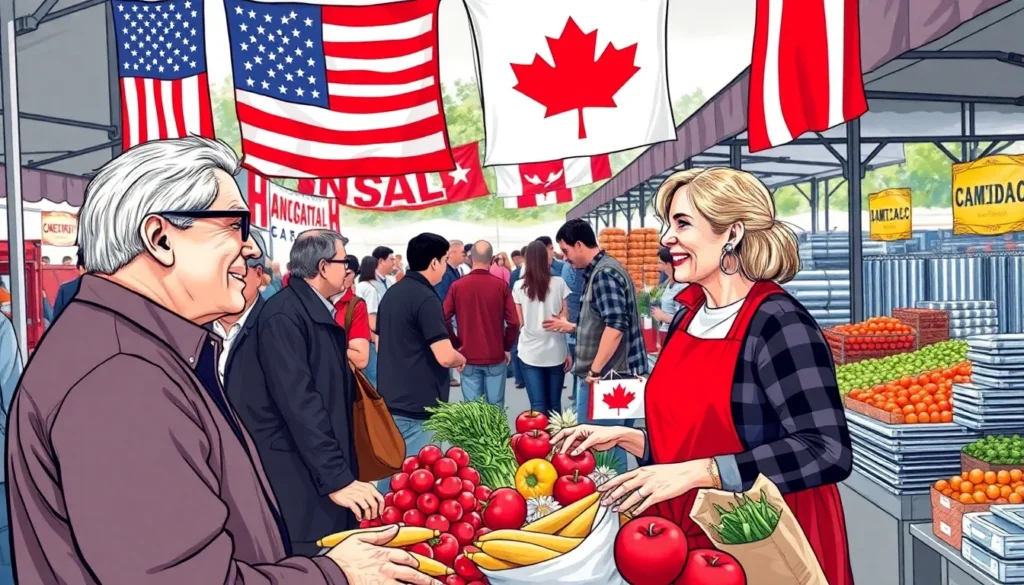When it comes to trade, the Canada-US relationship is like a high-stakes game of poker—full of bluffs, surprises, and the occasional wild card. Enter the Trump tariffs, a bold move that turned the friendly neighbors into sparring partners. These tariffs didn’t just shake hands; they threw a few punches, leaving both economies to wonder what’s next in this unpredictable showdown.
As businesses on both sides of the border scrambled to adapt, the impact of these tariffs rippled through supply chains and consumer prices. With a mix of humor and frustration, many Canadians and Americans alike found themselves navigating the complex world of trade policies that seemed to change faster than the weather in the Great White North. Buckle up as we dive into the twists and turns of this trade saga, exploring the real implications of those tariffs and what they mean for the future.
Table of Contents
ToggleOverview of Canada US Trade Relations
Canada and the US maintain one of the largest trading relationships globally. Trade between these nations reached approximately $712 billion in 2020, highlighting the depth of economic interdependence. The trade deal known as the United States-Mexico-Canada Agreement (USMCA) further solidified these ties. This agreement replaced the North American Free Trade Agreement (NAFTA) and aimed to modernize trade between the three countries.
Tariffs implemented during the Trump administration, particularly on steel and aluminum, disrupted this established relationship. Businesses in both countries faced challenges, leading to increased costs and supply chain interruptions. As a result, Canadian exporters felt pressure from the tariffs, with many seeking alternative markets. The uncertainty surrounding these policies affected investment decisions in both nations.
Connections between Canadian and American industries remain significant. The automotive sector serves as a prime example, with many vehicles crossing the border multiple times during production. Agriculture also plays a critical role, as Canadian and US farmers rely on reciprocal access to markets. Trade in services, such as technology and finance, accounts for a substantial portion of the economic interaction, fostering innovation and collaboration.
Trade policy shifts have global implications for both countries. Changes in tariffs can lead to broader economic trends, emphasizing the importance of stable regulations. Understanding the dynamics of Canada-US trade today reflects not just bilateral relations, but the intricate web of global commerce in which they participate. These ongoing developments indicate that the relationship between Canada and the US will continue shaping economic landscapes.
Impact of Trump Tariffs on Trade

Trump tariffs have significantly reshaped trade dynamics between Canada and the US. The application of these tariffs has created strains in the previously amicable trade relationship.
Key Tariffs Imposed
In 2018, Trump implemented tariffs of 25% on steel and 10% on aluminum, targeting both Canadian imports and other international sources. These levies aimed to bolster domestic production but resulted in increased costs for industries relying on these materials. Consequentially, Canadian exporters faced an uphill battle in maintaining market access, as retaliatory measures were enacted. Canada responded with its own tariffs on a range of US goods, encompassing products like whiskey and various agricultural items. This escalating trade conflict underscores the volatility that tariffs bring to the broader economic landscape.
Affected Sectors and Industries
Several sectors, particularly automotive and agriculture, experienced pronounced impacts due to these tariffs. Automotive manufacturing in Canada relies heavily on cross-border supply chains, facing cost increases from aluminum and steel tariffs. Shrinking margins prompted some Canadian manufacturers to rethink production strategies. Conversely, the agricultural sector dealt with retaliatory tariffs on exports, leading to decreased competitiveness in key markets. Services such as technology and finance also felt the ripple effects as shifted investments created uncertainty. Tariffs disrupted not only goods but have reshaped comprehensive trade frameworks between the two nations.
Canada’s Response to Tariffs
Canada has taken notable steps in response to US tariffs, seeking to mitigate the negative impact on its economy and businesses.
Government Policies Implemented
The Canadian government quickly retaliated against US tariffs, imposing tariffs on a variety of American products. A 25% tariff on steel and a 10% tariff on aluminum targeted US imports. These measures aimed to protect domestic industries and address market imbalances. Additional counter-tariffs affected goods such as whiskey and orange juice, showcasing Canada’s commitment to defending its trade interests. Canadian authorities also provided financial assistance to affected sectors, helping businesses adapt to the altered trade landscape.
Trade Agreements and Negotiations
Trade agreements play a crucial role in Canada’s approach to tariffs. The United States-Mexico-Canada Agreement (USMCA) emerged as a key framework for modernizing trade relations. Canada actively engaged in negotiations to strengthen access to the US market, emphasizing the importance of maintaining stable trade conditions. Ongoing discussions have focused on resolving trade disputes, aiming for a mutually beneficial outcome for both nations. The evolving trade landscape requires continuous dialogue to protect Canadian exporters and ensure long-term economic stability.
Economic Consequences
The Trump tariffs imposed significant economic consequences on the Canada-US trade relationship. These tariffs altered trade dynamics between the two nations, impacting various sectors and consumers alike.
Trade Balance Analysis
Trade balances shifted due to the imposition of tariffs, with Canada experiencing notable impacts on its exports. In 2020, trade between Canada and the US reached $712 billion, showcasing the interdependence of their economies. Canadian businesses, especially in manufacturing and agriculture, faced challenges adjusting to new tariff structures. Retaliatory tariffs imposed by Canada targeted a variety of American goods, further complicating trade balances. The consequences of these tariffs on trade volume led to increased scrutiny over long-term economic strategies. Overall, both countries need to address these disruptions to restore a more favorable trade balance.
Effects on Consumers and Businesses
Consumers in both Canada and the US observed rising prices due to the tariffs. Increased costs of steel and aluminum translated to higher prices for automotive and construction industries, leading to broader economic implications. Local businesses struggled to absorb these costs, resulting in a decline in profit margins. For instance, imported goods experienced price hikes as tariffs led to inflationary pressures on finished products. Canadian exporters sought alternative markets to offset lost access to the US, driving changes in global supply chains. Ultimately, the consequences of the tariffs extended beyond policy adjustments, affecting everyday consumers and businesses that rely on stable trade.
Future of Canada US Trade Relations
Canada and the US share a vibrant trade ecosystem, but uncertainty looms due to recent developments. The evolving landscape of tariffs prompts market participants to consider potential shifts in policy.
Potential Policy Changes
Policy adjustments may redefine the Canada-US trade relationship. Both governments could alter tariffs or implement new trade agreements to address existing tensions. Changes in leadership might influence these policies, especially with potential negotiations on trade terms. Protectionist measures from the US could prompt Canada to advocate for more equitable terms. As economic pressures build, stakeholders might witness movements toward easing restrictions or redefining priorities in bilateral trade. Experts suggest that a collaborative approach could mitigate losses incurred due to tariffs.
Ongoing Trade Discussions
Trade discussions continue as both nations navigate challenges. Frequent dialogues between Canadian and American officials aim to resolve lingering trade disputes. Meetings have covered various topics, including tariffs, supply chain management, and market access. Key industry stakeholders participate in these conversations, advocating for improved frameworks benefiting both countries. Policies fostering cooperation could arise from these negotiations, promoting stability in trade relations. Such discussions play a crucial role in understanding each country’s priorities, paving the way for potential agreements that enhance economic ties.
The evolving trade landscape between Canada and the US reflects the significant impact of Trump tariffs on both economies. As businesses navigate these challenges they must adapt to fluctuating policies and rising costs. The strong economic ties between the two nations underscore the importance of collaboration in addressing trade disruptions.
Future discussions between Canadian and American officials will be crucial in finding solutions that benefit both sides. By working together to resolve existing tensions and improve market access they can foster a more stable trading environment. This collaborative spirit will be essential for ensuring that the economic interdependence between Canada and the US continues to thrive despite recent obstacles.









